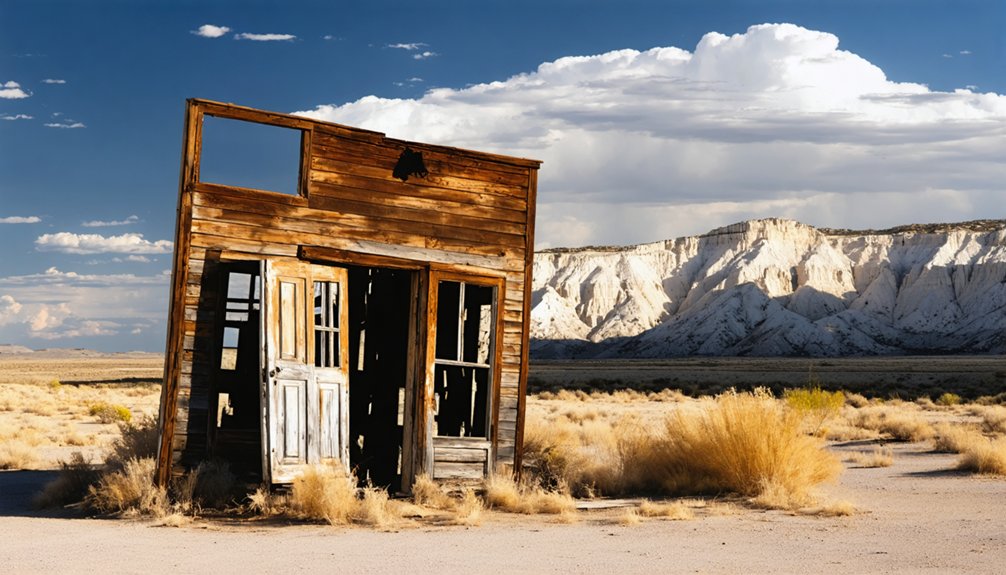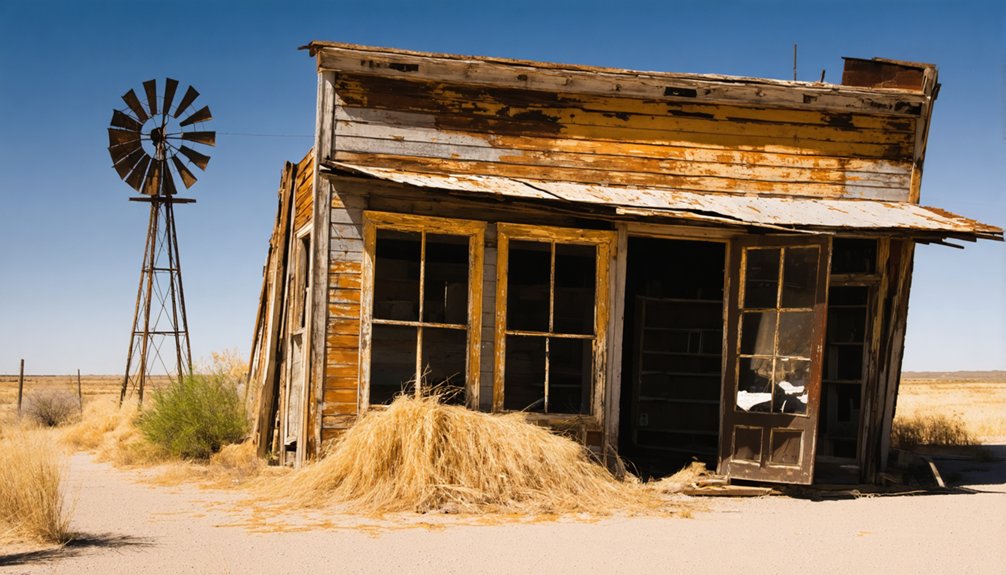You’ll find Mount Blanco’s ruins nestled beneath a distinctive white limestone mesa in Crosby County, Texas. As West Texas’ first settlement in the 1870s, it grew around Henry Clay Smith’s Rock House – a 22-inch thick stone fortress that served as the region’s first post office and crucial stop along Col. Mackenzie’s military trail. Local tales still whisper of phantom riders and ghostly cattle drives echoing across Stampede Mesa’s rugged terrain.
Key Takeaways
- Mount Blanco was West Texas’ first settlement, established in the 1870s around Henry Clay Smith’s Hacienda Glorieta ranch.
- The historic Rock House, built in 1877, served as the region’s first post office and community center with 22-inch thick walls.
- The town developed along Colonel Mackenzie’s military trail, which was crucial for moving Comanche tribes to reservations.
- Today, only ruins and a 1975 historical marker remain, along with the white mesa that gave Mount Blanco its name.
- Local folklore includes tales of phantom riders and ghostly cattle herds near Stampede Mesa, dating back to the 1800s.
The Rise of West Texas’ First Settlement
While the Caprock escarpment had long stood as a formidable barrier to westward expansion, Mount Blanco emerged as West Texas’ pioneering settlement in the 1870s.
You’ll find its origins tied to Col. Mackenzie’s military trail, which drove Comanche tribes onto reservations and opened the region for settlement. The area’s clear springs and rivers caught the eye of early settlers, particularly Henry Clay Smith, who established Hacienda Glorieta ranch in 1877. Charles Tasker originally started the ranch but faced financial difficulties and had to abandon it. The Rock House became a key stop along the military trail, which was the only road crossing the Llano Estacado at that time.
As the first permanent resident of Crosby County, Smith’s influence sparked rapid community growth. His Rock House, built in 1878 with locally quarried stone, became Mount Blanco’s essential hub when it gained the region’s first post office in 1879.
Smith’s pioneering spirit and Rock House transformed Mount Blanco into a thriving settlement, anchored by the county’s first post office.
Smith’s wife Elizabeth served as postmistress, anchoring the settlement’s communication with the outside world.
Life at the Historic Rock House
Standing as a demonstration to frontier ingenuity, the Rock House emerged as more than just West Texas’ first permanent home when Henry Clay Smith completed its construction in 1877.
Life within its 22-inch thick stone walls centered around daily routines of self-sufficiency, as your nearest neighbors would’ve been 50 miles away. You’d find the house bustling with activity as it served multiple purposes – a family residence, post office, and community gatherings hub.
While Mrs. Elizabeth Smith managed postal duties for 37 years, you’d witness travelers, prospectors, and settlers stopping by for rest and supplies. Before the Rock House was established, settlers had to travel 175 miles to Fort Griffin for their mail service.
The commissary within the rock wall enclosure became an essential lifeline, supporting both the Smith family’s ranching operations and weary travelers along the military trail that crossed the vast Llano Estacado. The site’s historical significance was marked by the birth of Crosby County’s first white child at this location.
Ranching Legacy and Military Trails
When Charles Tasker handpicked Mount Blanco as the site for his ambitious ranching venture in the late 1870s, he’d launch what would become the first permanent settlement in Crosby County, Texas.
Under his direction, Henry Clay Smith established Hacienda Glorieta and introduced 500-600 cattle, setting the foundation for regional ranching practices.
You’ll find the location’s military significance dates to 1872 when Colonel Mackenzie’s Fourth U.S. Cavalry mapped the only trail crossing the Llano Estacado.
This strategic route proved essential for westward expansion, with Smith’s Rock House serving as an important way-station.
After Tasker’s financial troubles, Smith took control, building the two-story stone homestead directly on the military trail.
The site’s dual importance as a ranching headquarters and military thoroughfare cemented Mount Blanco’s role in Texas frontier history.
Like many early Texas settlements, Anglo-American pioneers faced significant challenges traveling to the region due to rough terrain and limited transportation routes.
The nearest mail service was at Fort Griffin, 175 miles away, until Smith’s house became the local post office in 1879.
Folklore and Phantom Riders
Throughout the haunted mesas of Mount Blanco, you’ll encounter tales of spectral cowboys who ride endlessly across the rugged terrain of Crosby County.
Similar to the ancient Indian campground that later became Devil’s Backbone Tavern, these lands hold deep historical significance for Native American tribes.
Local ranchers tell of ghostly sightings near Stampede Mesa, where phantom herds and shadowy riders appear at dusk, accompanied by the thunderous sounds of hooves and cattle.
The haunting echoes of phantom hooves and spectral riders still resonate across Stampede Mesa as dusk settles over the land.
These haunting tales trace back to the dangerous frontier days of the 1800s, when the Fourth U.S. Cavalry mapped trails through contested territory.
The phantom riders often materialize along old military roads and cattle driving routes, marking sites of tragic stampedes and violent conflicts between settlers and Native Americans.
Many visitors report a distinct feeling of being followed while exploring the area’s remote trails, adding to Mount Blanco’s mysterious reputation.
You’ll hear stories of these supernatural guardians appearing on moonlit nights, their eternal patrols serving as both warning and reminder of Mount Blanco’s untamed past.
Modern Day Remnants and Heritage

While ghostly legends echo across Mount Blanco’s landscape, the physical remnants of this historic settlement tell their own compelling story.
You’ll find a historical marker erected in 1975 north of where Henry Clay Smith’s Rock House once stood before burning down in 1952. The white mesa that gave Mount Blanco its name still towers as a natural landmark, while Blanco Canyon’s geological features reveal the stone quarries that built this pioneer outpost.
Like many semi-abandoned towns in Texas, only scattered ruins mark what was once a bustling community. Today, you won’t find the church that closed in 1965 or the store that shuttered in 1956, but archaeological features remain, including traces similar to those found at Blowout Cave in northern Blanco County.
The paths of Farm Road 193 and the old military trail still cut through the terrain, and scattered foundation stones whisper tales of ranching operations and frontier life from Texas’s untamed past.
Frequently Asked Questions
How Did Mount Blanco Settlers Survive Extreme Weather Conditions on the Plateau?
You’d survive through practical weather adaptations like building stone homes with thick walls, collecting rainwater, practicing dry farming, storing preserved foods, and maintaining survival strategies passed down from Native Americans.
What Indigenous Tribes Previously Inhabited the Mount Blanco Area?
By 1871, over 20,000 Comanches controlled this region. You’ll find their tribal history dominates Mount Blanco’s past, though Lipan Apache ancestors also shaped the area’s indigenous culture before Spanish arrival.
Were There Any Documented Conflicts Between Settlers and Native Americans?
You’ll find significant settler conflicts in the area, including the 1871 Battle of Blanco Canyon where Col. Mackenzie’s forces fought Comanche warriors, plus numerous raids marking sustained Native resistance to territorial expansion.
What Happened to the Smith Family Descendants After Leaving Mount Blanco?
You’ll find the Smith family’s journey led them to disperse across Texas, though their legacy impact endures through the Pioneer Memorial Museum, Hank Smith Park, and continued ranching traditions in Crosby County.
Can Visitors Legally Access the Original Mount Blanco Site Today?
You can’t legally access the original ghost town site today without obtaining permissions from private landowners, as it’s located on restricted ranch property off Farm Road 193 in Crosby County.
References
- https://www.tshaonline.org/handbook/entries/mount-blanco-tx
- https://daytrippintexas.com/panhandle/abandoned-farmhouse-in-mount-blanco/
- https://sites.rootsweb.com/~txcrosby/community/mt.blanco.htm
- https://www.txgenwebcounties.org/blanco/communities.html
- https://texoso66.com/2023/06/22/stampede-mesa-and-ghost-riders-in-the-sky/
- https://www.historictexas.net/city/mount-blanco-texas
- https://www.texasescapes.com/TexasPanhandleTowns/Mount-Blanco-Texas.htm
- https://en.wikipedia.org/wiki/Mount_Blanco
- https://en.wikipedia.org/wiki/List_of_ghost_towns_in_Texas
- https://www.texasescapes.com/TOWNS/Texas-Ghost-Towns-3-Hill-Country.htm



